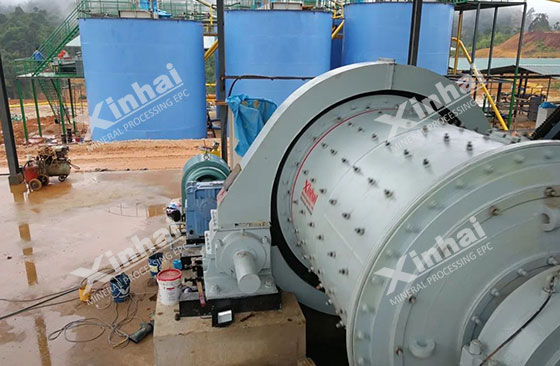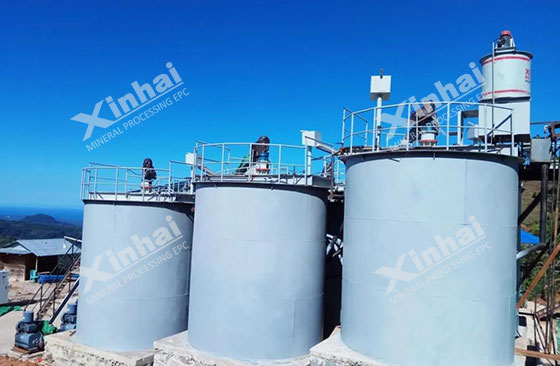
The gold ore carbon slurry method (CIP), which is the all-mud cyanide carbon slurry method to extract gold, is one of the main methods of cyanide gold extraction. After all the gold ore is ground into pulp, it is first leached by cyanide, and then activated carbon is used to directly adsorb the dissolved gold from the pulp. The gold mud is then extracted by carbon desorption and electrolysis, thereby achieving gold recovery. The carbon slurry method is suitable for processing low-grade, complex and fine-grained disseminated gold ores, such as disseminated gold ores, amalgamated or gravity separation tailings, and argillaceous oxidized ores. This process effectively reduces labor and material costs and significantly improves economic benefits due to its low equipment requirements, short process and few operators.
In the preparation stage, the gold ore is first processed to the required particle size by crushing and grinding. The raw ore is crushed through two or three closed-circuit processes, and the powder ore particle size reaches -12mm. The coarse crushing equipment is a jaw crusher, and the medium or fine crushing equipment is a cone crusher. Subsequently, the ore is processed through two stages of grinding, and the fineness reaches at least 80%-200 mesh. The coarse grinding uses a grate ball mill, and the fine grinding uses an overflow ball mill. After crushing and grinding, the concentration of the pulp after grinding and classification does not meet the standards for cyanide leaching, so it needs to be concentrated and dehydrated. The pulp is dehydrated by an efficient concentrator, and impurities such as sawdust in the pulp are removed at the same time, so that the pulp concentration is increased to 40~42% to meet the requirements of cyanide leaching.

After impurities are removed and concentrated, the cyanide pulp is sent to multiple stepped leaching tanks for leaching under appropriate temperature, pH value and oxygen content conditions. Sodium cyanide reacts chemically with gold minerals, and gold is dissolved and converted into gold-cyanide complexes. In order to ensure that the reaction is fully carried out, the pulp needs to be stirred continuously during the leaching process, usually using 5 to 8 stirring tanks, which is similar to the conventional cyanidation method. At the same time, the leaching time and reagent concentration need to be strictly controlled to increase the leaching rate of gold.
After the slurry after cyanide leaching is introduced into the adsorption tank, the activated carbon begins to adsorb. Because the activated carbon has a highly developed pore structure and a huge specific surface area, it can fully contact with the slurry and efficiently adsorb the gold ions in the solution by countercurrent adsorption. In this process, the gold-cyanide complex is transferred from the solution to the surface of the activated carbon to form gold-loaded carbon. In order to achieve the reverse flow of activated carbon and slurry, the adsorption tank is equipped with a carbon screen and a slurry lifterto improve the adsorption efficiency of gold.

The desorption electrolysis process of gold-loaded carbon is usually combined with electrolytic deposition equipment to form a production cycle system. First, the gold-loaded carbon is loaded into a desorption tower (or desorption column), and the prepared desorption liquid is pumped into the system. The desorption methods mainly include normal temperature and pressure desorption method and high temperature and high pressure desorption method. These methods usually have high desorption rate and electrolysis rate, high degree of automation, short operation time, and no need to use sodium cyanide. During the desorption process, anions that are easily adsorbed by activated carbon are added to the desorption liquid, thereby replacing the gold-cyanide complex and realizing the desorption of gold.
The precious liquid after desorption is used to recover gold through electrolysis or displacement. Electrolysis recovers gold by applying direct current to the cathode to reduce and deposit the gold-cyanide complex. In this process, parameters such as current density, voltage and solution temperature need to be controlled to improve the recovery rate and purity of gold. The displacement method uses active metals such as zinc powder to reduce the gold-cyanide complex in the desorption solution to metallic gold. In the process, the amount of displacement agent and reaction time need to be controlled to ensure the complete recovery of gold.

In order to ensure the long-term effectiveness of activated carbon in the gold extraction process, the regeneration cycle of de-goldened carbon is essential. During the adsorption process, the pores of activated carbon may be blocked by inorganic substances in the slurry such as Ca(OH)₂, Mg(OH)₂ particles, clay sludge or excessive base metal ions and organic substances such as lubricating oil, detergent, flotation agent, humic acid, etc., resulting in reduced activity. In order to restore the activity of carbon, acid washing and pyrolysis can be used.
The acid pickling method uses dilute hydrochloric acid or dilute nitric acid (concentration 1-5%) for 2-4 hours at room temperature to remove calcium, zinc and other compounds on the carbon. Using a hot acid solution at 90-93°C can remove calcium, zinc, nickel compounds and most silicon. If the pores of the carbon are severely blocked by silicates, it needs to be treated with a hydrofluoric acid (HF) aqueous solution.

Fire regeneration uses the principle of high temperature heating. By heating in a regeneration kiln (600-800℃), it can effectively remove organic and inorganic matter on the carbon and restore the adsorption capacity of the carbon. The treated activated carbon needs to be cooled and screened, and then it can be re-added to the cyanide slurry for adsorption recycling.
Cyanide-containing leached slurry cannot be discharged directly. When treating it, it can be effectively decomposed or neutralized by methods such as oxidation with a sodium hypochlorite generator, oxidation with chlorine gas, or absorption with alkaline solution after acidification and volatilization to ensure that the slurry meets safety and environmental protection standards before discharge.

When designing the full-slime cyanidation process, it is necessary to conduct mineral processing tests based on the ore to determine the specific process flow, process parameters and equipment layout. Only on the basis of a full understanding of the ore characteristics and test results can a safe and reliable gold production process be designed to ensure the production efficiency of the mineral processing plant.
To find out more about our products and solutions, please fill out the form below and one of our experts will get back to you shortly.